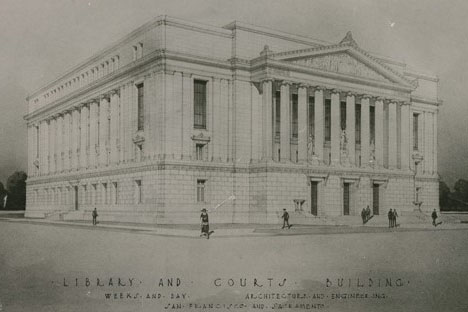Ghost stories, at their root, are a type of history. These supernatural histories often involve real people, specific locations, and events, intersected with an overlapping struggle, conflict, achievement or untimely tragedy that results in the triggering of odd or unexplainable occurrences. The Library and Courts Building, home today to a portion of the California State Library, was constructed against a backdrop of political intrigue, financial difficulties, and competing viewpoints. The library was erected as part of the Capitol Extension Group project which included the existing Capitol building completed in 1874, and two new buildings: the Library and Courts Building, and the State Office Building. The initial project funding and subsequent construction took place from 1913–1928. During this period, the project underwent funding crises, changes in commission personnel, personality clashes, and disagreements.

One area of friction that existed before, and during, the construction of the library was competing viewpoints regarding the location of California’s capital city. By the 1910s there were eighteen state departments located in San Francisco, more than were in Sacramento. The California Supreme Court had been holding its sessions solely in San Francisco since 1878. There was a concerted movement by many to designate San Francisco as the capital city. To maintain its stature as the capital, the citizens of Sacramento voted to approve $700,000 in bonds to purchase two blocks west of the Capitol building for the construction of two new buildings. One of the approved buildings was to hold the State Library on the first four floors, and the Supreme Court and Court of Appeal on the fifth floor. The second building would provide office space for state departments.
The Sacramento State Buildings Commission was created to oversee the construction of the new buildings. The commission members did not always agree, particularly about library and court space allocation. Consequently, reports of conflicts exist in recorded accounts and correspondence from this period. The commission included the Governor, the Chief Justice of the California Supreme Court, the Chairman of the Board of Control, the State Librarian, the State Architect, and the Superintendent of the Capitol Building. The only two officials who remained constant throughout the entire construction phase were George B. McDougall, State Architect; and George G. Radcliff, Superintendent of the Capitol Building.
There were several preeminent architects and artists who invested their time and talent to create the impressive structures of the Capitol Extension Group. The architectural firm of Weeks & Day were awarded the contract for design. Charles P. Weeks designed not only the buildings, but many of the grand fixtures that fill them. Sculptor Edward Field Sanford, Jr. created the massive pediments and sculptures of the imposing new buildings. Artist Maynard Dixon created the dramatic mural “Pageant of Traditions” which adorns the walls of the library in Gillis Hall, and artist Frank Van Sloun painstakingly created the exquisite murals located in the vestibule of the building. These librarians, officials, justices, and artists all invested years of time and effort to create the magnificent Library and Courts Building…who could blame them if they wanted to stay.

